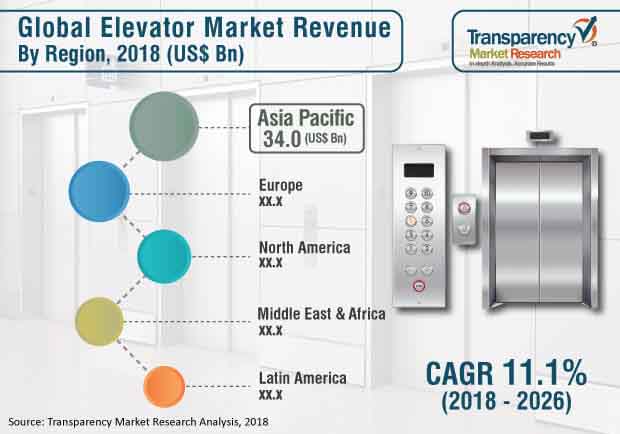
Global Elevator Market – Snapshot
Elevator is a vertical mode of transport that helps people or goods to move between floors of a building. An elevator is operated by electric motors, which either drives traction cables or pumps hydraulic fluid depending on the type of elevator. Hydraulic elevators operate with the help of a piston that supports the elevator cab from the bottom. Hydraulic elevators are mostly used in low rise apartments. Traction elevators have cable (ropes were used earlier) that pass over a wheel attached to a motor that is located above the elevator shaft.
Traction elevators have high speed compared to hydraulic elevators. Hence, traction elevators can be used for mid to high rise apartments. Pneumatic elevators work by controlling air pressure within the elevator’s chamber. Vacuum pumps or turbines are designed to track the flow of air in the chamber of the elevator. Pneumatic elevators are found mostly in residential homes where digging a pit is not feasible.
You will get Custom Report at Syndicated Report price, Buy Now

The global elevator market has been segmented on the basis of deck type, destination control, building height, end-use, speed, application, and region. Based on deck type, the market is segmented into single and double deck. As compared to double deck, single deck elevators are more widely used globally.
Based on destination control, the elevator market is classified into smart and conventional. The conventional segment held major share in the global elevator market. In conventional elevators, the passenger has to push the up or down button to go to the desired floor. In terms of building height, the elevator market is segmented into low rise, mid rise, and high rise. Mid rise segment accounted for major share in 2017 followed by the low rise segment. High rise buildings are increasing in number and are expected to contribute considerable share to the elevators market in the near future.
Get More Press Releases by TMR:https://www.prnewswire.com/news-releases/artificial-intelligence-market-valuable-applications-for-host-of-functions-across-a-spectrum-of-industries-extends-lucrative-growth-opportunities-explains-worth-predicted-to-surpass-us-2-8-bn-by-2030—tmr-301282109.html
Based on end-use, the elevator market has been segmented into residential, commercial, and mix block. Residential has the major share across the globe; however commercial and mix block segments are expanding steadily over time. In terms of speed, the market is classified into – less than 1m/s, between 1 to 3 m/s, between 4 to 6 m/s, between 7 to 10 m/s, and above 10m/s. The most common segment is between 1 to 3 m/s in developing countries. Based on application, the elevator market is segmented as passenger and freight. Passenger elevators held major share in 2017.
The Asia Pacific elevator market is driven by factors such as rapid urbanization, demographic changes, increasing demand for skyscrapers etc. China dominates the elevator market followed by India and Japan. Although Asia Pacific forms the major chunk of the elevator market, the demand for elevators is expected to increase globally during the forecast period. This is due to construction of high rise buildings in the coming years. Companies are expanding their portfolio by introducing advanced techniques to increase speed and shorten the travel time.
Are you a start-up willing to make it big in the business? Grab an exclusive, PDF Brochure of this report
The elevator market is consolidated due to the dominance of few strong players. Otis Elevator Company, KONE Oyj, Schindler, Fujitec Co., Ltd., Hitachi, Ltd., Hyundai Elevator Co., Ltd., Electra Elevators, Mitsubishi Electric Corporation, Thyssenkrupp AG, and Toshiba Corporation are the key companies profiled in the research report. The report also offers competitive landscape of key players in the elevator market.





